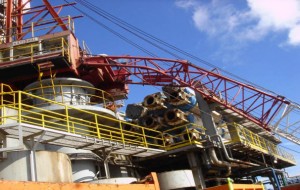Accountability, proper procedures key to reducing wire rope failures
By Katie Mazerov, contributing editor

The wire rope is the most critical functioning component on a rig crane, and lack of proper inspection procedures is the root cause of 90% of cable failures, said Andy Schott, senior mechanical supervisor for Diamond Offshore Drilling, during a panel session at the 2012 IADC Lifting and Mechanical Handling Conference & Exhibition, 18-19 July in Lafayette, La. “The key word is accountability,” said Mr Schott, who oversees more than 115 cranes worldwide. “All the paper rules and procedures won’t stop wire rope failures. Only you as individuals can stop failures by improving operator awareness and competency requirements for operators and mechanics. This involves everyone from the operator to the offshore installation manager (OIM) to the mechanic to third-party inspectors.”
Joining Mr Schott on the panel were Leon Schopping, lifting & hoisting principle technical expert for Shell, and Roman Predl, offshore crane rope manager for TEUFELBERGER Seil GmbH, a manufacturer of products for lifting, conveying and securing cargo. The three experts emphasized that pre-inspection and ongoing inspection procedures, proper lubrication and tension maintenance, along with an awareness of crane type and usage can minimize wire rope failures, enhance safety and reduce costs.
“The cost of not doing a 30-minute or hourlong inspection can result in millions of dollars of downtime and transportation expenses,” Mr Schott said. He noted that API’s recommended procedures call for visual inspections of wire rope by a qualified crane operator prior to use, monthly and during quarterly and annual inspections. But operators also should take into account specific circumstances, such as weather conditions and degree of use, in establishing inspection protocols. They should routinely check the mechanical aspects of the wire rope path, remove lubrication to check groove depth, inspect the sheave bearings, retainers, fleet angles and how the wire is laying on the drum.
To increase accountability for wire rope safety and performance, Diamond Offshore has enhanced reporting procedures with a Daily Crane Operators Report that requires the signature of the operator, rig mechanic, OIM and barge supervisor after every shift. “We have had a reduction in wire rope failures and reductions in crane problems and breakdowns, downtime and costs associated with these issues,” Mr Schott said.
Know What to Inspect
Among the challenges in inspecting wire ropes is knowing when and what to look for when only 20% of the 10,000 ft (30,000 meters) of cable on a fully rigged crane is visible, Mr Schopping said. A key component of the wire that is not visible is the core.
“Inspect the wire where it is expected to fail,” he suggested. “Wire rope is good at handling tension. The problems start when the wire bends. Determine where most of the bends occur during the lifting operation, for example, the end terminations.”
He also cautioned against routinely replacing wire ropes as an alternative to inspections or investing in quality. He cited the case of a North Sea operator that routinely replaced wire rope every year, yet experienced an increase in incidents because inspection procedures became lax. “Crews must conduct routine inspections because lives depend on them. A broken wire rope will result in fatalities.”
Proper wire rope installation procedures are also critical, Mr Predl said. “Before installing the wire rope, inspect the complete conveying system to ensure there are no negative imprints, avoid fleet angles and check the groove sizes of the sheaves or drum (if grooved, which is common in the US) and the actual diameter.” Other factors to consider include:
- The minimum breaking force;
- Whether the left or right lay is the suitable direction;
- Sizes (metric or imperial), especially in the case of grooved drums;
- Use galvanized rope in offshore applications;
- Follow proper procedures for uncoiling the wire rope;
- Apply minimum tension during installation; and
- Use fully lubricated ropes with plasticized steel core.
“Lubrication is important because it protects the wire rope from corrosion and reduces friction,” Mr Predl advised. “Keeping the rope lubricated will extend the life of the cable.”




